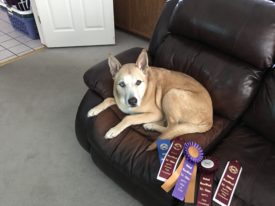I tend to look at the world a little differently.
This won’t shock many of you.
I love coaching dogs and their people. As a coach, I am always looking for ways to help my teams improve, whether they have a puppy that’s just being a puppy (but you fear you may not let the dog live past tomorrow), or whether your team is about to step into the competitive NoseWork world for the first time.
Many times, the solutions teams seek to puzzle me. Other times, I reach a point in training my own dogs that may not become necessary for my students, but I have the time to train through it myself and pass that information along when the opportunity presents itself.
I look at almost everything with my dogs as a training opportunity. But I don’t necessarily present it to my dogs as training. Don’t get me wrong. I used to do that. To the detriment of my dogs…and me. Most importantly to us as a team. Once I FINALLY realized what I was doing, I started to examine the WHY part of that puzzle.
I am competitive. Fully admit to it and own it. I grew up in the highly competitive world of figure skating. Lots of pressure. Lots of training. Ultimately, lots of competing and showing. What I didn’t realize then, but I do now, is that I really rather enjoyed the training. The competing made me a nervous wreck. Yet when I started to compete with my dogs, I didn’t think of the correlation.
Insert dope-slap here.
There is inherent pressure to perform well in dog sport competitions. I mean, you train hard. You have goals. You want to show everyone how special your dog is and how great your team is. And you are! But sometimes, competing just isn’t in the cards.
In fact, you may never want to compete. Or if you do, you don’t want to travel to do it. Your dog may incur an injury that prevents doing that sport you love. Or, your dog isn’t up to the pressure you might inadvertently be putting on yourself and letting it travel down the leash.
I’m here to tell you…THAT’S OK. And here’s why: reframe your thinking.
How? I’m glad you asked.
Every situation I find myself in with my dogs or teams that I coach teaches me something. I mean EVERY situation. Say I’m trying to work through a tough sequence in Freestyle…I might let Mollie dictate how we do a particular move. And it turns out GREAT. Reward that dog – it’s the best thing she’s ever done (at least to date)!
Or in a NoseWork trial, I might see a handler pull their dog off a scent or do a correction…and I make a mental note to teach my teams how to avoid that in training so it doesn’t carry over to trial.
Or I just watch teams as they work on an agility sequence, and I note that what the handler intended to do and what they did were not the same…but the sequence was a success. WOOHOO! Reward that dog!
Many of you hear me in your head: “Train like you trial and trial like you train”. And that’s when it hit me: because I am having fun training and listening to my own advice, it’s been a long time since I’ve felt nervous going into the ring. I am not viewing the trial as a death march of potential embarrassment…I’m looking at it as an opportunity to have fun with my 4-legged partners and to see where we need to improve.
And that has made all the difference.


